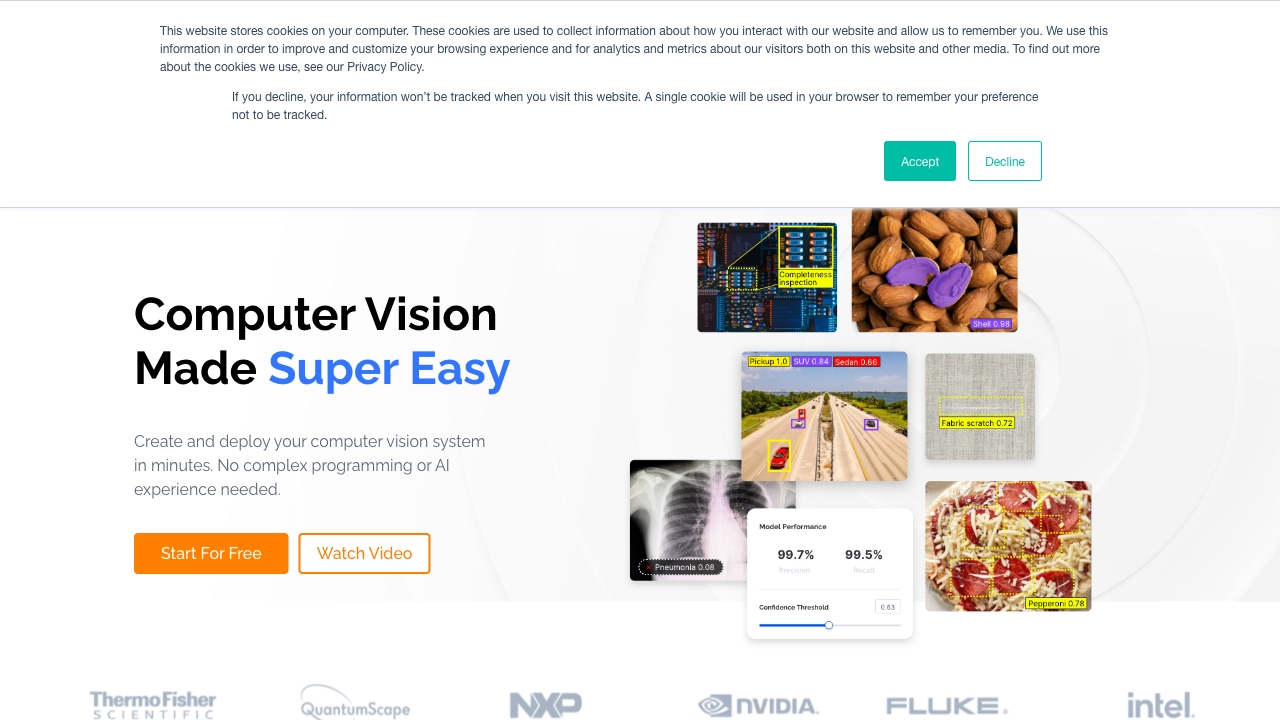- Home
- AI Image Recognition
- Landing AI

Landing AI
Open Website-
Tool Introduction:Train accurate computer vision with limited data; deploy at scale.
-
Inclusion Date:Nov 01, 2025
-
Social Media & Email:
Tool Information
What is Landing AI
Landing AI is a Visual AI platform built around a data-centric AI approach, helping organizations with limited datasets turn computer vision ideas into production systems. Its flagship product, LandingLens, streamlines the lifecycle—from data collection and labeling to model training, evaluation, deployment, and monitoring—so teams can scale beyond proof of concept. With deep learning, robust MLOps, and integrations like LandingLens on Snowflake and Agentic Document Extraction, Landing AI enables AI-driven automation across manufacturing and enterprise operations.
Main Features of Landing AI
- Data-Centric Workflow: Tools for labeling, quality control, and iterative improvement to boost model accuracy with fewer images.
- LandingLens Visual AI: End-to-end computer vision pipeline for classification, detection, and segmentation projects.
- MLOps and Versioning: Model experiments, audit trails, and deployment orchestration to manage models at scale.
- Edge, Cloud, and On‑Prem Deployment: Flexible runtime targets for production lines, gateways, or cloud APIs.
- Monitoring and Drift Alerts: Performance dashboards, thresholding, and alerts to detect data and model drift.
- LandingLens on Snowflake: Bring models to your data for in-platform inference and streamlined data governance.
- Agentic Document Extraction: Vision-language extraction for documents, invoices, and forms with AI assistants.
- Collaboration & Governance: Role-based access, labeling policies, and review workflows for enterprise teams.
- APIs and SDKs: Integrations with existing systems, data lakes, and factory equipment.
Who Can Use Landing AI
Landing AI suits manufacturing and operations teams seeking reliable visual inspection, AI/ML engineers building computer vision apps, and quality engineers who need scalable defect detection. It also helps data scientists standardize MLOps, IT/OT leaders deploy models to edge devices, and business analysts automate document extraction for back-office workflows.
How to Use Landing AI
- Connect data sources: upload images/videos, link storage, or integrate cameras; optionally connect Snowflake datasets.
- Create a project in LandingLens, define classes or defect types, and set labeling guidelines.
- Annotate samples using built-in tools; apply review to ensure consistent, high-quality labels.
- Train models with recommended settings; use augmentation and active learning to improve with fewer images.
- Evaluate precision/recall and confusion matrices; iterate with new labels to reduce errors.
- Deploy to cloud API, edge devices, or on‑prem containers; configure thresholds and runtime parameters.
- Integrate via API/SDK or factory systems; set up alerts and workflow automations.
- Monitor performance and drift; schedule retraining and manage versions with MLOps tools.
Landing AI Use Cases
Common applications include defect detection and quality inspection in electronics, automotive, and consumer goods; assembly verification and PPE compliance on production lines; packaging and label checks in food and pharma; inventory counting and shelf analytics in retail; and Agentic Document Extraction for invoices, purchase orders, claims, and back-office documents.
Landing AI Pricing
Landing AI typically offers custom, quote-based pricing tailored to enterprise needs, considering factors like project scope, number of users, deployment targets (cloud/edge/on‑prem), and support requirements. Organizations can engage with the team to scope pilots and scale to production under an enterprise agreement.
Pros and Cons of Landing AI
Pros:
- Data-centric workflow improves accuracy with limited datasets.
- End-to-end computer vision pipeline with robust MLOps.
- Flexible deployment across edge, cloud, and on‑prem environments.
- Snowflake integration streamlines secure, governed data operations.
- Monitoring and drift detection support continuous production reliability.
Cons:
- Primarily focused on computer vision; broader AI needs may require additional tools.
- Advanced enterprise features may require significant investment.
- Results depend on data quality and consistent labeling practices.
- Edge deployments can require specialized hardware and IT/OT coordination.
FAQs about Landing AI
-
What is LandingLens?
LandingLens is Landing AI’s visual AI platform that manages data labeling, model training, deployment, and monitoring for computer vision projects.
-
Can it work with small datasets?
Yes. The data-centric workflow, active learning, and augmentation are designed to improve performance when data is limited.
-
Does it support edge deployment?
Landing AI supports deployment to edge devices, cloud services, and on‑prem environments to meet production requirements.
-
What is LandingLens on Snowflake?
It enables running vision workloads closer to data in Snowflake, helping simplify governance, security, and operational efficiency.
-
Does it handle documents as well as images?
Yes. Agentic Document Extraction applies vision-language AI to automate data capture from structured and semi-structured documents.







